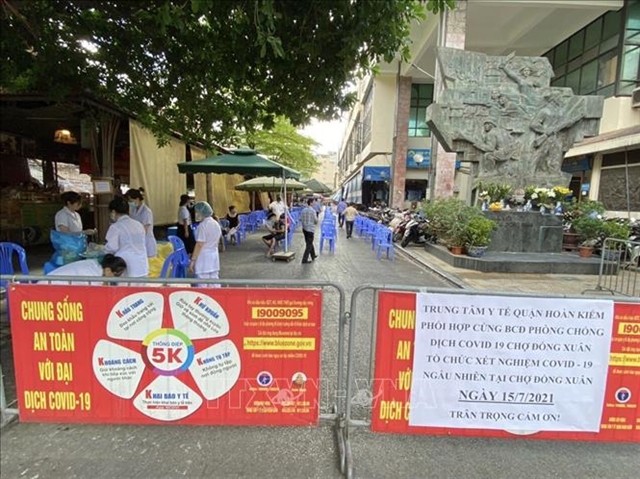 Society
Society


|
| Hà Nội takes random COVID-19 tests in Đồng Xuân Market in Hoàn Kiếm District. VNA/VNS Photo |
HÀ NỘI — Health minister Nguyễn Thanh Long has said the ongoing fourth wave of COVID-19 infections is much more serious than any before it.
Speaking at a national online meeting about COVID-19 on Friday morning, Long said despite drastic actions, localities, especially HCM City and southern provinces, were facing very complex COVID-19 outbreaks, with much more negative impacts on daily life as well as socio-economic development than the previous waves.
In the coming days, they would see more new infections and deaths relating to COVID-19, he said.
Long said the three previous waves of COVID-19 were brought under control within a month to a month and a half, but the Delta variant present in the fourth wave could spread two to three times faster than the original coronavirus.
The Delta variant could attach tightly to host cells, rapidly multiply in large numbers in the cells and then destroy the cells, and spread pathogens to the environment in a short time, Long explained, adding that a person could now infect others only two days after catching the virus, not five as before.
Meanwhile, people were not strictly following social distancing measures and health recommendations, Long said.
“It’s difficult to stop infections when people still flock to markets, industrial zones, and still fail to meet preventive rules,” Long said, adding that some localities had yet to prepare for the worst-case scenario.
At the meeting, Long also highlighted basic changes in responding to COVID-19 outbreaks.
For example, home quarantine is being piloted for close contacts of COVID-19 cases.
Quick tests would be used predominantly rather than PCR tests so positive SARS-CoV-2 cases would be detected and isolated sooner.
The health ministry also recommended using pooled sample testing with 3-5 samples per test.
The ministry also changed its COVID-19 treatment strategy so that patients with light illness or asymptomatic patients are treated in primary healthcare facilities designed to receive COVID-19 patients.
Patients with symptoms would be transferred to health facilities and those with serious illnesses would be taken to general hospitals or field hospitals.
Asymptomatic patients who tested positive for SARS-CoV-2 twice but have a low viral load, known as a cycle threshold (CT) below 30, can be discharged from the hospital without 14 days of quarantine due to the low likelihood they will spread the virus to others. The patients are asked to monitor their health at their residence for 14 days.
SARS-Cov-2 positive cases detected in the community with a CT value of at least 30 will be re-tested after 24 hours. If their CT value remains over 30 after the second test, they don’t need to stay in the hospital but can monitor their health from home.
According to the ministry’s statistics, of more than 400 people who tested positive again after being declared cured, none infected others. So, health authorities recommend localities don’t need to isolate the areas which report re-positive cases.
“Such changes in treatment help reduce the number of inpatients and medical workers can concentrate on patients with critical health problems,” Long said.
Regarding COVID-19 vaccinations, Long said Việt Nam had successfully negotiated for the delivery of about 170 million doses.
However, due to limited supply, the arrivals of vaccines to Việt Nam would be slow until September this year, he said, adding that some deals were made last September but vaccine delivery had only been made recently.
“The health ministry will give priority to provinces/cities with COVID-19 outbreaks or those that are socio-economic drivers of the country first to help them soon achieve the twin goals of disease prevention and control alongside socio-economic growth,” he said.
As soon as receiving vaccines, localities must implement vaccination plans, he said.
New COVID-19 prevention and control directive proposed
The Ministry of Health has asked for a new Prime Minister’s Directive on COVID-19 prevention and control to respond to new developments of the pandemic in Việt Nam.
Currently, COVID-19 prevention and control measures are regulated in Directives 15, 16 and 19 which were issued early last year by then-Prime Minister Nguyễn Xuân Phúc.
However, outbreaks in industrial parks, markets and crowded residential areas during the fourth wave have revealed the limitations of current measures. For example, many localities have faced difficulties in dealing with a high number of infections reported at the same time.
Meanwhile, after Việt Nam successfully controlled the third wave, people seemingly lost vigilance against the disease as they ignored or did not strictly follow preventive rules, the ministry said.
According to the ministry’s proposal, all resources must be used to control the disease as soon as possible, helping people return to normal daily life.
Prioritised groups will be adjusted in line with the development of outbreaks at a particular time and after Việt Nam achieves herd immunity, the vaccination programme will be expanded.
The proposal also said that depending on the pandemic's development, the country may have to choose between the dual goals of disease prevention and control and economic growth.
In the proposal, the ministry introduced four levels of risk compatible with four areas – an area in the new normal, an area with risks, an area with high risks and an area with very high risk.
In areas under the new normal, people must still follow the health ministry’s 5K message: Khẩu trang (face mask) – Khử khuẩn (disinfection) – Khoảng cách (distance) – Không tụ tập (no gathering) – Khai báo y tế (health declaration). Businesses are also required to take preventive measures.
In areas with very high risks, concentrated quarantine areas would be set up in locations with many suspected cases.
A 14-day lockdown would be imposed on the areas. During the lockdown, people must stay at home and only go out if very necessary. Non-essential businesses and public transportation would be suspended from operation. VNS




